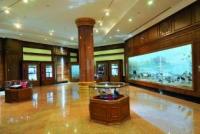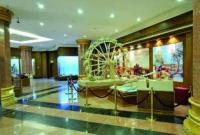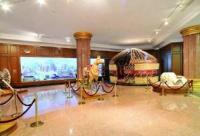Вы здесь
Museum Ethnography in Ashgabad.



Excursions on Ashgabad museums.
Museum of ethnography and local history of the Main National Museum of Turkmenistan was opened on 18-th May 2009. The three-story building adjacent to the main building of the museum.
On the ground floor of the museum houses an exposition of the nature of Turkmenistan, on the second - ethnography of the Turkmen people. Nature and Local History Department consists of eleven chapters.
The first section deals with the birth of the universe (where you’ll see one of the valuable exhibits – KunyaUrgench meteorite) and the evolution of life on Earth with sections where are the fossils of ancient organisms and fingerprints found on the territory of Turkmenistan.
Among them, unique dinosaur footprints (aged about 150 million years), found in the south-eastern Turkmenistan (Hojapil plateau), the world's only traces of ancient camel Arvana (age of 2.5 million years), located in Western Kopetdag, jaw fragment with teeth of forest elephant and mandibular teeth of Khazar elephant that lived in the territory of Turkmenistan 100-200 thousand years ago.
The second section of the museum introduces the Physical features of Turkmenistan. Here are: climate map and the map of water basins, soil monoliths and minerals of Turkmenistan. From the third to the tenth section, the visitor gets acquainted with the regions of Turkmenistan.
A trip begins with Koytendagmountains, which are represented in exposition by karsticKarluk caves, deep-water Kettekol Lake and others. The North of the country is presented by dioramas “Kaplankyr” and “Lake Sarykamysh” with its vegetable and animal world.
There is a unique place in the South of Turkmenistan – Badkhyz and reserve of the same name, founded in 1941 for preservation of head of livestock of onagers. A splendid diorama in this part shows us nature monuments: Yeroylanduzlake and wild pistachio sparse growth of trees.
There is also collection of insects and arachnids. One of the biggest dioramas is devoted to Kopetdagmountains and you can see here vegetable and animal world of the mountains: bezoar goat, wild ram, Western Asian leopard, marten, brown bear, wolf and birds – griffon, goshawk, partridge and others.
Karakum desert occupies 80% of territory of Turkmenistan. Diorama devoted to it presents: gazelle, caracal, tolay hare, desert monitor, sand cat, bustard and others. Turan tiger exposed in “Amudarya” diorama is one of the valuable exhibits of Department of nature.
Turkmenistan is situated on the way of seasonal migration of many kinds of birds, inhabitants of tundra, north seas, lakes, rivers, forests and steppes. There are 109 kinds of birds in exposition of museum and many of them are included into Red Data book of Turkmenistan and International Community of Nature Protection.
Show-cases devoted to Nature Protection and containing portraits of biologists of Turkmenistan complete the exposition. In the part of ethnography are shown traditions and customs of Turkmen nation and exposed everyday life, national garments, handicraft, arms, musical instruments and jewelry.
Exposition is founded on the basis of ancient historical information, which is the source of life and activity of Turkmens. For that purpose at the beginning of exposition is shown the earliest period of development of culture with its character features.
This ancient historical monument is situated on the North-West of Ashgabat and named Jeytun culture, belongs to 3-rd millennium B.C. Altyndepe, which belongs to the Bronze Age, is considered to be the first town in the territory of Turkmenistan. Agriculture, handicraft and art have originated here.
Part of ancient history is completed by the historical monument of 2-nd millennium B.C. – state of Margush. Turkmen young men always distinguished by their courage and masterful use of weapons.
There are shield, spear, chain mail, steel sabres, swords and knives of XVIII-XIX centuries and guns used in battles. Farming was a primary occupation of settled tribes and this diorama, which shows presowing hard work at the foothills of Kopetdag mountains, is devoted to it.
In other show-cases are exposed labour tools and articles used in agriculture There was widely spread production of vegetable oil out of sesame and cotton seeds and was used oil press “juvaz”, which was activated with a help of domestic animals – camel or donkey.
Water was always valued for Turkmen people. in every village there were elders (yashuly) who exactly determined the place of future well or kyariz (underground water galleries). In one of show-cases are exposed articles for well sinking.
The inhabitants of the Amidarya valley used for irrigation different installations: jykyr and depme nova and raised the water level. They are shown in exposition large as life. Seaside inhabitants were basically occupied with fishing, which is shown in separate diorama.
Nomadic tribes were busy with cattle breeding and hunting. There are traps, shot, other articles and information about hunting dog – tazy and falconry. Tamdyr - clay stove for baking, which is used at the present time as well- is exposed large as life.
White yurta in decoration especially attracts attention. Here you can see such carpet products as torba – wall bag for tableware; chuval - wall bag for clothes; akja yup - priceless heirloom; umur-duman– carpet for decoration of ceiling and floor carpets.
Turkmen people have historically existing wedding traditions and ceremonies. It is shown in one of the big and beautiful dioramas. Turkmens considered a horse to be a member of family. Pride of Turkmen nation akhalteke horse decorates the exposition and here you can see special horse adornments made of silver.
Turkmen people are busy with silkworm breeding since the period of Silk way, but fabrics woven by Turkmen women differ by their special, national and original colouring. Carpet weaving arises in ancient days.
Turkmen women have woven and weave genuine masterpieces of art out of Sardja sheep's wool with a help of simple tools - keser (knife), darak (comb) and scissors. National jewelry made out of silver with gilding and adorned with semiprecious stones and differs by its special beauty and elegance. Not only women, but men as well wore adornments.
Then you can see work of blacksmith, potter and shoemaking.
The most valuable steel swords and sabres of XIX century are exposed in show-cases. Woman's, men's and children's garments from five provinces is amazing by its variety, colour and destination. The majority of show-cases expose them.
Exposition is completed by demonstration of national musical instruments – dutar, gidjak, gargy tuyduk, dilli tuyduk (tubes) and others.
Authority and photos:
http://www.museum.gov.tm







